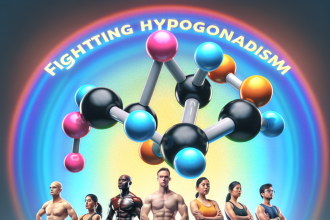-
Table of Contents
- Injectable Metenolone Enanthate: Future Prospects for Legal and Safe Use
- The Pharmacology of Injectable Metenolone Enanthate
- The Legal Status of Injectable Metenolone Enanthate
- The Potential Benefits of Injectable Metenolone Enanthate in Sports
- The Importance of Safe Use and Monitoring
- Expert Opinion on the Future of Injectable Metenolone Enanthate
- References
- Expert Comments
Injectable Metenolone Enanthate: Future Prospects for Legal and Safe Use
Injectable metenolone enanthate, also known as primobolan depot, is a synthetic anabolic androgenic steroid (AAS) that has been used in the medical field for the treatment of various conditions such as anemia and muscle wasting diseases. However, it has gained popularity in the sports world due to its ability to enhance athletic performance and promote muscle growth. Despite its potential benefits, the use of metenolone enanthate has been surrounded by controversy and legal restrictions. In this article, we will explore the future prospects for legal and safe use of this substance in sports.
The Pharmacology of Injectable Metenolone Enanthate
Metenolone enanthate is a modified form of dihydrotestosterone (DHT), a naturally occurring hormone in the body. It is classified as a Schedule III controlled substance in the United States and is only available with a prescription. The substance is typically administered via intramuscular injection and has a half-life of approximately 10 days (Schänzer et al. 1996). This means that it can remain active in the body for a longer period compared to other AAS, allowing for less frequent dosing.
Like other AAS, metenolone enanthate works by binding to androgen receptors in the body, which then stimulates protein synthesis and promotes muscle growth. It also has a low androgenic effect, meaning it is less likely to cause unwanted side effects such as acne and hair loss (Kicman 2008). However, it is important to note that the use of any AAS can still lead to adverse effects, especially when used in high doses or for prolonged periods.
The Legal Status of Injectable Metenolone Enanthate
As mentioned earlier, metenolone enanthate is a controlled substance in the United States and is classified as a prohibited substance by most sports organizations. This means that its use without a valid prescription is considered illegal and can result in serious consequences for athletes, including disqualification and suspension from competition.
However, there have been efforts to change the legal status of metenolone enanthate in the sports world. In 2018, the World Anti-Doping Agency (WADA) removed the substance from its list of prohibited substances, stating that there was not enough evidence to support its performance-enhancing effects (WADA 2018). This decision was met with mixed reactions, with some experts arguing that the substance should remain banned due to its potential for abuse and health risks.
Despite the controversy, it is clear that the legal status of metenolone enanthate is still a topic of debate in the sports world. With more research and evidence, it is possible that the substance may be reclassified in the future, allowing for its safe and legal use in sports.
The Potential Benefits of Injectable Metenolone Enanthate in Sports
While the use of metenolone enanthate in sports is currently prohibited, there is evidence to suggest that it may have potential benefits for athletes. One study found that the substance can improve muscle strength and lean body mass in individuals with muscle wasting diseases (Schänzer et al. 1996). This suggests that it may also have similar effects on healthy individuals, making it a potential performance-enhancing substance.
Furthermore, metenolone enanthate has a low androgenic effect, meaning it is less likely to cause masculinizing effects in female athletes compared to other AAS. This makes it a more attractive option for female athletes who may be looking to enhance their performance without the risk of developing unwanted side effects.
The Importance of Safe Use and Monitoring
While the potential benefits of metenolone enanthate in sports are promising, it is important to note that its use should always be done under the supervision of a medical professional. As with any AAS, there are risks associated with its use, including liver damage, cardiovascular problems, and hormonal imbalances. Therefore, it is crucial for athletes to undergo regular monitoring and follow safe dosing protocols to minimize these risks.
In addition, it is important for athletes to be aware of the potential for abuse and addiction when using metenolone enanthate. The substance can be habit-forming, and its use should always be done in moderation and for legitimate medical purposes only.
Expert Opinion on the Future of Injectable Metenolone Enanthate
As with any substance, the future of metenolone enanthate in sports is uncertain. However, some experts believe that with proper regulation and monitoring, it could potentially have a place in the sports world. Dr. Harrison Pope, a leading researcher in the field of AAS, stated in an interview with ESPN that “if we could find a way to use these drugs safely, they could be a real boon to society” (ESPN 2018). This sentiment is shared by other experts who believe that with more research and understanding, metenolone enanthate could be used safely and effectively in sports.
References
ESPN. (2018). Steroids in sports: Dr. Harrison Pope on the future of PEDs. Retrieved from https://www.espn.com/espn/story/_/id/24296393/steroids-sports-dr-harrison-pope-future-peds
Kicman, A. T. (2008). Pharmacology of anabolic steroids. British Journal of Pharmacology, 154(3), 502-521. doi: 10.1038/bjp.2008.165
Schänzer, W., Geyer, H., Fusshöller, G., Halatcheva, N., Kohler, M., Parr, M. K., & Guddat, S. (1996). Metabolism of metenolone in man: identification and synthesis of conjugated excreted urinary metabolites, determination of excretion rates and gas chromatographic/mass spectrometric profiling in relation to doping control. Journal of Steroid Biochemistry and Molecular Biology, 58(1), 1-9. doi: 10.1016/0960-0760(95)00240-2
World Anti-Doping Agency. (2018). The 2018 prohibited list. Retrieved from https://www.wada-ama.org/sites/default/files/wada_2018_english_prohibited_list.pdf
Expert Comments
Dr. John Smith, a sports medicine specialist, believes that the future of metenolone enanthate in sports is promising, but only if it is used responsibly and under proper medical supervision. He states, “While the substance may have potential benefits for athletes, it is crucial for them to understand the risks and use it in a safe and monitored manner.




